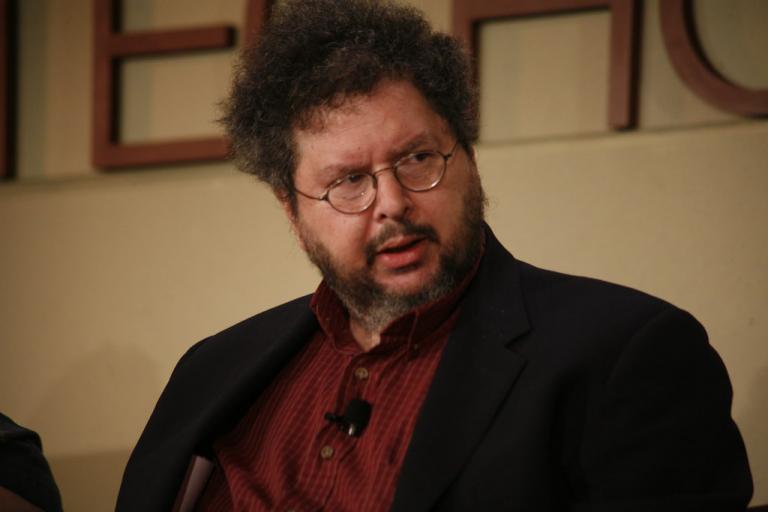David Gelertner–a mathematician, an important computer scientist, a full professor at Yale–has announced that he no longer accepts Darwinism.
Gelertner, who was seriously injured by the Unabomber terrorist, said that he was influenced by three books: Stephen Meyer’s Darwin’s Doubt (which he calls “one of the most important books in a generation”); David Klinghoffer’s Debating Darwin’s Doubt; and David Berlinski, The Deniable Darwin.
Gelertner is not a Christian (he is Jewish), he does not accept the literal creation account in the Bible, and he does not fully accept Intelligent Design. But he is convinced that Darwin’s theory of evolution, which accounts for the origin of species by random mutations and natural selection, while a “beautiful theory,” just can’t account for the evidence.
Gelertner explains why in an essay he wrote for the Claremont Review entitled Giving Up Darwin. He discusses, for example, how the random formation of the proteins necessary for life is mathematically impossible, how the Cambrian Explosion–in which a plethora of life forms suddenly appears in the fossil record with no earlier versions–is evidence against Darwinism, and how studies have shown that all major mutations are fatal and so could not provide survival advantages that lead to new species.
Read the whole article, but here are some excerpts:
Darwinian evolution is a brilliant and beautiful scientific theory. Once it was a daring guess. Today it is basic to the credo that defines the modern worldview. Accepting the theory as settled truth—no more subject to debate than the earth being round or the sky blue or force being mass times acceleration—certifies that you are devoutly orthodox in your scientific views; which in turn is an essential first step towards being taken seriously in any part of modern intellectual life. But what if Darwin was wrong?
Like so many others, I grew up with Darwin’s theory, and had always believed it was true. I had heard doubts over the years from well-informed, sometimes brilliant people, but I had my hands full cultivating my garden, and it was easier to let biology take care of itself. But in recent years, reading and discussion have shut that road down for good.
This is sad. It is no victory of any sort for religion. It is a defeat for human ingenuity. It means one less beautiful idea in our world, and one more hugely difficult and important problem back on mankind’s to-do list. But we each need to make our peace with the facts, and not try to make life on earth simpler than it really is. . . .
Darwin’s theory predicts that new life forms evolve gradually from old ones in a constantly branching, spreading tree of life. Those brave new Cambrian creatures must therefore have had Precambrian predecessors, similar but not quite as fancy and sophisticated. They could not have all blown out suddenly, like a bunch of geysers. Each must have had a closely related predecessor, which must have had its own predecessors: Darwinian evolution is gradual, step-by-step. All those predecessors must have come together, further back, into a series of branches leading down to the (long ago) trunk.
But those predecessors of the Cambrian creatures are missing. Darwin himself was disturbed by their absence from the fossil record. He believed they would turn up eventually. Some of his contemporaries (such as the eminent Harvard biologist Louis Agassiz) held that the fossil record was clear enough already, and showed that Darwin’s theory was wrong. Perhaps only a few sites had been searched for fossils, but they had been searched straight down. The Cambrian explosion had been unearthed, and beneath those Cambrian creatures their Precambrian predecessors should have been waiting—and weren’t. In fact, the fossil record as a whole lacked the upward-branching structure Darwin predicted.
The trunk was supposed to branch into many different species, each species giving rise to many genera, and towards the top of the tree you would find so much diversity that you could distinguish separate phyla—the large divisions (sponges, mosses, mollusks, chordates, and so on) that comprise the kingdoms of animals, plants, and several others—take your pick. But, as Berlinski points out, the fossil record shows the opposite: “representatives of separate phyla appearing first followed by lower-level diversification on those basic themes.” In general, “most species enter the evolutionary order fully formed and then depart unchanged.” The incremental development of new species is largely not there. . . .
The ever-expanding fossil archives don’t look good for Darwin, who made clear and concrete predictions that have (so far) been falsified. . . .
Darwin’s main problem, however, is molecular biology. There was no such thing in his own time. We now see from inside what he could only see from outside, as if he had developed a theory of mobile phone evolution without knowing that there were computers and software inside or what the digital revolution was all about. . . .
So how hard is it to build a useful, well-shaped protein? Can you throw a bunch of amino acids together and assume that you will get something good? Or must you choose each element of the chain with painstaking care? It happens to be very hard to choose the right beads. . . .
It’s easy to see that the total number of possible sequences is immense. It’s easy to believe (although non-chemists must take their colleagues’ word for it) that the subset of useful sequences—sequences that create real, usable proteins—is, in comparison, tiny. But we must know how immense and how tiny.
The total count of possible 150-link chains, where each link is chosen separately from 20 amino acids, is 20150. In other words, many. 20150 roughly equals 10195, and there are only 1080 atoms in the universe.
What proportion of these many polypeptides are useful proteins? Douglas Axe did a series of experiments to estimate how many 150-long chains are capable of stable folds—of reaching the final step in the protein-creation process (the folding) and of holding their shapes long enough to be useful. (Axe is a distinguished biologist with five-star breeding: he was a graduate student at Caltech, then joined the Centre for Protein Engineering at Cambridge. The biologists whose work Meyer discusses are mainly first-rate Establishment scientists.) He estimated that, of all 150-link amino acid sequences, 1 in 1074 will be capable of folding into a stable protein. To say that your chances are 1 in 1074 is no different, in practice, from saying that they are zero. It’s not surprising that your chances of hitting a stable protein that performs some useful function, and might therefore play a part in evolution, are even smaller. Axe puts them at 1 in 1077.
In other words: immense is so big, and tiny is so small, that neo-Darwinian evolution is—so far—a dead loss. Try to mutate your way from 150 links of gibberish to a working, useful protein and you are guaranteed to fail. Try it with ten mutations, a thousand, a million—you fail. The odds bury you. It can’t be done. . . .
To help create a brand new form of organism, a mutation must affect a gene that does its job early and controls the expression of other genes that come into play later on as the organism grows. But mutations to these early-acting “strategic” genes, which create the big body-plan changes required by macro-evolution, seem to be invariably fatal. They kill off the organism long before it can reproduce. This is common sense. Severely deformed creatures don’t ever seem fated to lead the way to glorious new forms of life. Instead, they die young.
Evidently there are a total of no examples in the literature of mutations that affect early development and the body plan as a whole and are not fatal. . . .
Darwin would easily have understood that minor mutations are common but can’t create significant evolutionary change; major mutations are rare and fatal.
It can hardly be surprising that the revolution in biological knowledge over the last half-century should call for a new understanding of the origin of species.
As a bonus, I offer you a video of Gelertner having a conversation about this essay with Stephen Meyer and David Berlinski, two of the writers who convinced him to give up on Darwinism. Observes David Klinghoffer, who edited the other book that influenced Gelertner, “This wonderful conversation gives you a sense of what a really free exchange of views would be like, the beauty and interest of it, were such a thing permitted on university campuses.”
Photo: “A Conversation with David Gelertner, Yale University” by Doc Searls via Flickr, Creative Commons 2.0 License.














